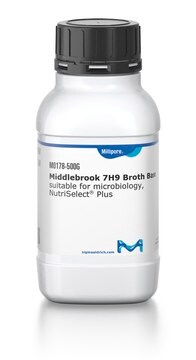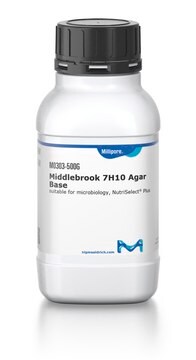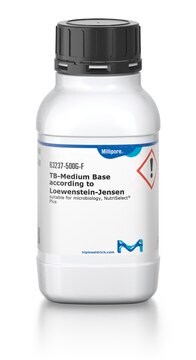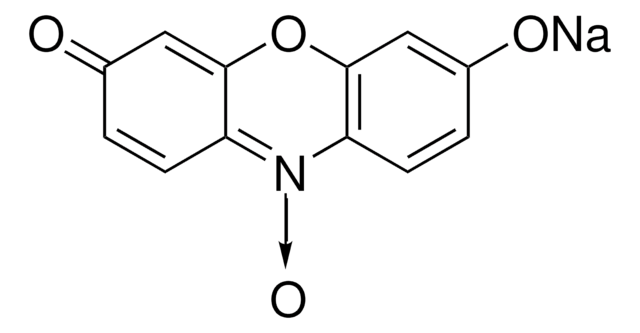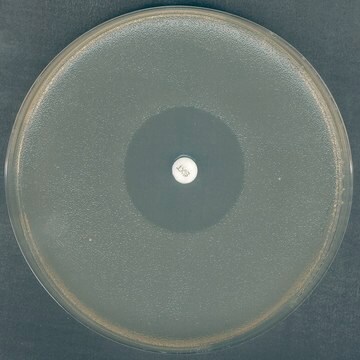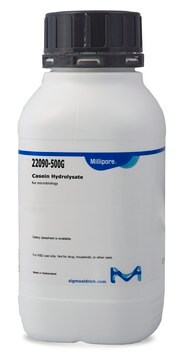M0428
Middlebrook 7H11 Agar Base
suitable for microbiology, NutriSelect® Plus
Synonym(s):
Media for culturing Mycobacteria
Sign Into View Organizational & Contract Pricing
All Photos(1)
About This Item
UNSPSC Code:
41171609
NACRES:
NA.85
Recommended Products
sterility
non-sterile
Quality Level
product line
BioChemika
form
powder
shelf life
limited shelf life, expiry date on the label
manufacturer/tradename
NutriSelect® Plus
storage condition
protect from light at room temperature
technique(s)
microbe id | susceptibility testing: suitable
microbiological culture: suitable
final pH
6.6±0.2 (25 °C)
application(s)
clinical testing
food and beverages
life science and biopharma
veterinary
microbiology
suitability
mycobacteria
Related Categories
General description
Middlebrook 7H11 Agar Base media is used for the isolation, cultivation, and sensitivity testing of Mycobacterium species. This agar base contains many inorganic salts which help the growth of Mycobacteria. Citric acid formed from sodium citrate helps in retaining inorganic cations in solution. Glycerol supplies carbon and energy. The Middlebrook OADC Supplement (M0678) contains oleic acid, bovine albumin, sodium chloride, dextrose and catalase. Oleic acid and other long chain fatty acids are essential for the metabolism of Mycobacteria. Dextrose is an energy source. Catalase neutralizes toxic peroxides. Albumin protects tubercle bacilli from toxic agents. Malachite green partially inhibits other bacteria.
Application
There are two types of solid culture media for the primary isolation of Mycobacteria. Egg-based (Lowenstein’s formulation) and agar-based (Middlebrook formulation)
The latter has the following advantages over the egg-based media
The Middlebrook 7H11 agar base does not liquify easily in the presence of contaminating proteolytic organisms
There is less inactivation of added drugs when egg ingredients are absent
The latter has the following advantages over the egg-based media
The Middlebrook 7H11 agar base does not liquify easily in the presence of contaminating proteolytic organisms
There is less inactivation of added drugs when egg ingredients are absent
Components
Ingredients (g/L)
Casein enzymatic hydrolysate, 1.00
Ammonium sulfate, 0.50
Monopotassium phosphate, 1.50
Disodium phosphate, 1.50
Sodium citrate, 0.40
Magnesium sulfate, 0.05
L-Glutamic acid, 0.50
Ferric ammonium citrate, 0.04
Pyridoxine, 0.001
Biotin, 0.0005
Malachite green, 0.001
Agar, 15.00
Casein enzymatic hydrolysate, 1.00
Ammonium sulfate, 0.50
Monopotassium phosphate, 1.50
Disodium phosphate, 1.50
Sodium citrate, 0.40
Magnesium sulfate, 0.05
L-Glutamic acid, 0.50
Ferric ammonium citrate, 0.04
Pyridoxine, 0.001
Biotin, 0.0005
Malachite green, 0.001
Agar, 15.00
Preparation Note
Suspend 10.25 g of Middlebrook 7H11 Agar Base in 450 ml of distilled water. Add 2.5 ml of glycerol (Cat. No. 49767). Boil to dissolve the medium completely. Sterilize by autoclaving at 15 lbs. pressure (121°C) for 15 minutes. Cool to 50°C and aseptically add 1 vial Middlebrook OADC Growth Supplement (M0678). Mix thoroughly before dispensing.
Footnote
We offer two media types: the superior granulated GranuCult® and the cost-efficient powdered NutriSelect® culture media, depending on your needs.
The designations basic, plus, or prime are added to indicate the quality control level, from basic quality control to standard QC plus to prime for full regulatory compliance.
The designations basic, plus, or prime are added to indicate the quality control level, from basic quality control to standard QC plus to prime for full regulatory compliance.
Legal Information
GRANUCULT is a registered trademark of Merck KGaA, Darmstadt, Germany
NutriSelect is a registered trademark of Merck KGaA, Darmstadt, Germany
related product
Storage Class Code
11 - Combustible Solids
WGK
WGK 3
Flash Point(F)
Not applicable
Flash Point(C)
Not applicable
Choose from one of the most recent versions:
Already Own This Product?
Find documentation for the products that you have recently purchased in the Document Library.
Customers Also Viewed
Thomas R Lerner et al.
The Journal of clinical investigation, 126(3), 1093-1108 (2016-02-24)
In extrapulmonary tuberculosis, the most common site of infection is within the lymphatic system, and there is growing recognition that lymphatic endothelial cells (LECs) are involved in immune function. Here, we identified LECs, which line the lymphatic vessels, as a
Shuxin Liang et al.
Autophagy, 16(8), 1453-1467 (2019-11-13)
BAG2 (BCL2 associated athanogene 2) is associated with cell fate determination in response to various pathological conditions. However, the effects of BAG2 on M. tuberculosis-induced endoplasmic reticulum (ER) stress remain elusive. Herein, we report that M. tuberculosis infection of macrophages
MacFaddin, J
Media for Isolation-Cultivation-Identification-Maintenance of Medical Bacteria, 1 (1985)
Our team of scientists has experience in all areas of research including Life Science, Material Science, Chemical Synthesis, Chromatography, Analytical and many others.
Contact Technical Service